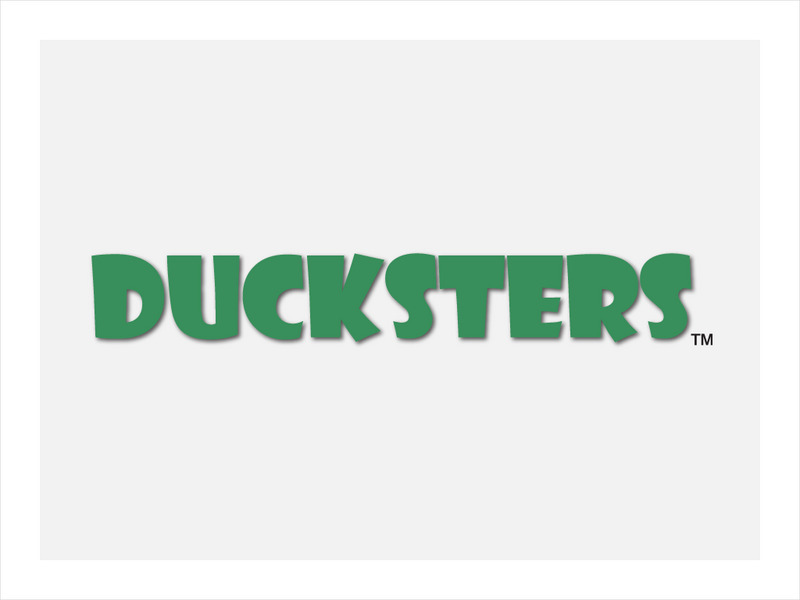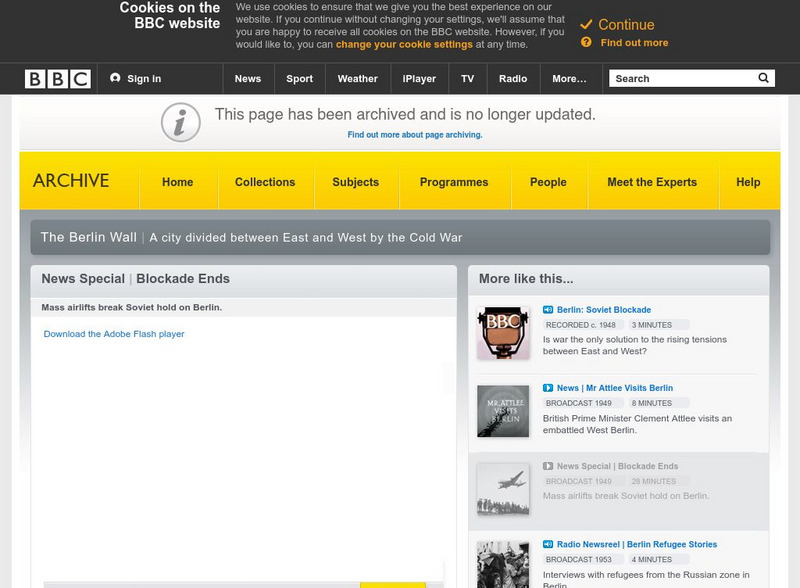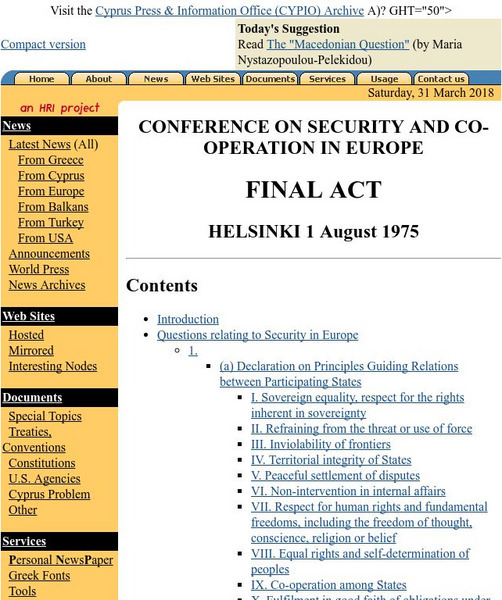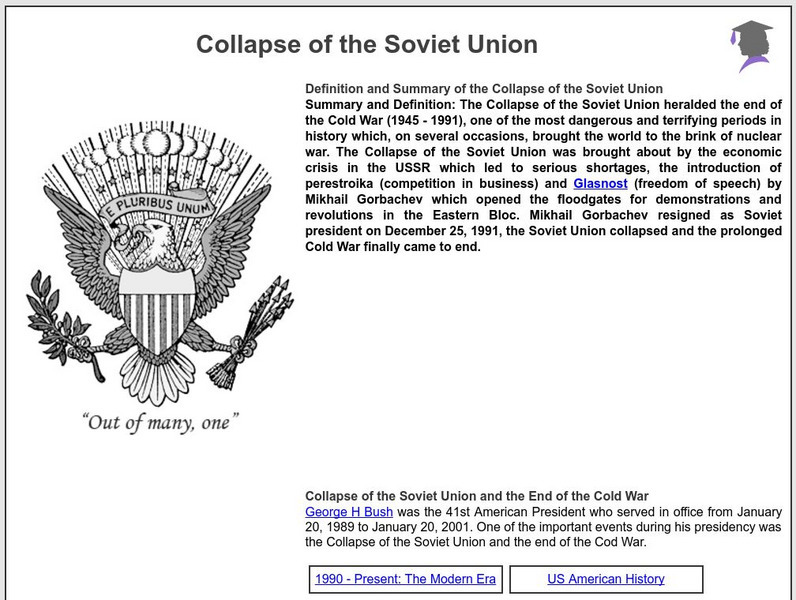Woodrow Wilson International Center for Scholars
Woodrow Wilson Center: Digital Archive: Inter Korean Relations After the War
This collection presents documents on inter-Korean relations from the end of the Korean War through the Park Chung Hee military coup.
Smithsonian Institution
National Portrait Gallery: The Presidency and the Cold War: George H. W. Bush
The National Portrait Gallery presents a look at the several presidents and their actions in regard to the Cold War. Click on George Bush to see and hear his speech about the dissolution of the Soviet Union. The Cold War ends.
Ducksters
Ducksters: The Cold War for Kids: Collapse of the Soviet Union
Kids learn about the history of the Collapse of the Soviet Union which put an end to the Cold War.
Other
Cold War Story: Chapter 1
This site gives a very brief mention of free elections that were agreed to at the end of the WWII. Site gives a great overview of how the Cold War emerged out of WWII. A very nice analysis!
Country Studies US
Country Studies: The Gulf War
Almost as soon as the Cold War ended, another war began. The First Persian Gulf stemmed from the Iraqi invasion and occupation of Kuwait and the threat that posed to other Persian Gulf states and the countries throughout the world that...
Smithsonian Institution
National Portrait Gallery: The Presidency and the Cold War: Ronald Reagan
The National Portrait Gallery presents a look at presidential actions and decisions about the Cold War. Click on Ronald Reagan to see how his anti-Communist beliefs led to increases in the defense budget, but also, by the end of his...
A&E Television
History.com: What Caused the Korean War and Why Did the Us Get Involved?
The Korean War (1950-1953) was the first military action of the Cold War. It was sparked by the June 25, 1950 invasion of South Korea by 75,000 members of the North Korean People's Army. The line they crossed, the 38th parallel, was...
Department of Defense
Do Dea: Ap Us History: Unit 9: Modern Times
This extensive learning module examines the extent to which conservatism successfully challenged liberal dominance in American culture and politics, and redefined economic policies and political behaviors. It looks at how the end of the...
Georgia Department of Education
Ga Virtual Learning: Ap Us History: The Modern Era
AP U.S. History on characteristics of the Modern Era, marked by a conservatism, end of the Cold War and emergent international terrorism. Complete set of resources, assignments and interactive learning materials.
BBC
Bbc: Red Army Enters Outskirts of Berlin
Find out how the Red Army's arrival in Berlin affected the Cold War.
The History Place
The History Place: Ronald Reagan: "Tear Down This Wall"
Primary source text, graphics, photos and audio-clips of President Reagan's historic speech given on June 12, 1987, in West Berlin calling for an end to the Cold War and the Berlin Wall.
Google Cultural Institute
Google Cultural Institute: Years of Change
A visual chronology of the fall of the Berlin Wall, the end of the Cold War, in East Germany from diary excerpts, historical snippets, and photographs. The German Reunification period ran from 1989-1991.
BBC
Bbc: Blockade Ends
This article and corresponding video discuss the end of the Berlin Blockade. Archived.
Independence Hall Association
U.s. History: The Korean War
A quick overview of the Korean War, its causes, outcome, and its role in the Cold War.
Smithsonian Institution
National Museum of American History: The End of the Cold War
A brief paragraph which summarizes the events which led to the end of the Cold War in 1991.
Smithsonian Institution
National Portrait Gallery: The Presidency and the Cold War: Jimmy Carter
The National Portrait Gallery explores the facets of presidential actions toward the Cold War. Click on Jimmy Carter to watch a short video where he expresses his support for human rights across the world. The end of the video shows the...
Boston University
Nato's Purpose: The Next Decade
An article explaining what NATO's purpose should be now that the Cold War has ended.
Gilder Lehrman Institute of American History
Gilder Lehrman Institute: History Now: Anti Communism in the 1950s
[Free Registration/Login Required] An essay tracing the anti-Communist hysteria beginning in earnest at the end of World War II that resulted in Truman's federal Loyalty Security program and ending with McCarthyism in the 1950s.
Center for Educational Technologies
Nasa Classroom of the Future: Korean Enigma: Korea Divided
Explores the historical events that took place between the United States and the USSR to bring about the political division of Korea on the 38th parallel into north and south after the end of World War II.
Other
Hellenic Resources Network: Helsinki Final Act 1975
This primary document is a copy of the Helsinki Agreements of 1975 which recognized the borders in central and Eastern Europe that were set up since the end of WWII. They show the acceptance of the Soviet influence in Eastern Europe. and...
Sam Houston State University
Shsu: The Warsaw Pact
Contains a wealth of information about the Warsaw Pact. Includes information about the Soviet Alliance System, the organization of East European National units, the development of Socialist Armies in Eastern Europe, East-West diplomacy...
Siteseen
Siteseen: American Historama: End of the Vietnam War
Provides a summary and detailed facts about the reasons for the end of the Vietnam war.
Siteseen
Siteseen: American Historama: Collapse of the Soviet Union
Broad discussion of the collapse of the Soviet Union and the end of the Cold War.
Khan Academy
Khan Academy: Us History: Period 9: 1980 Present: The Gulf War
Learn about how the United States led a UN coalition to liberate Kuwait from Iraq in 1991.























